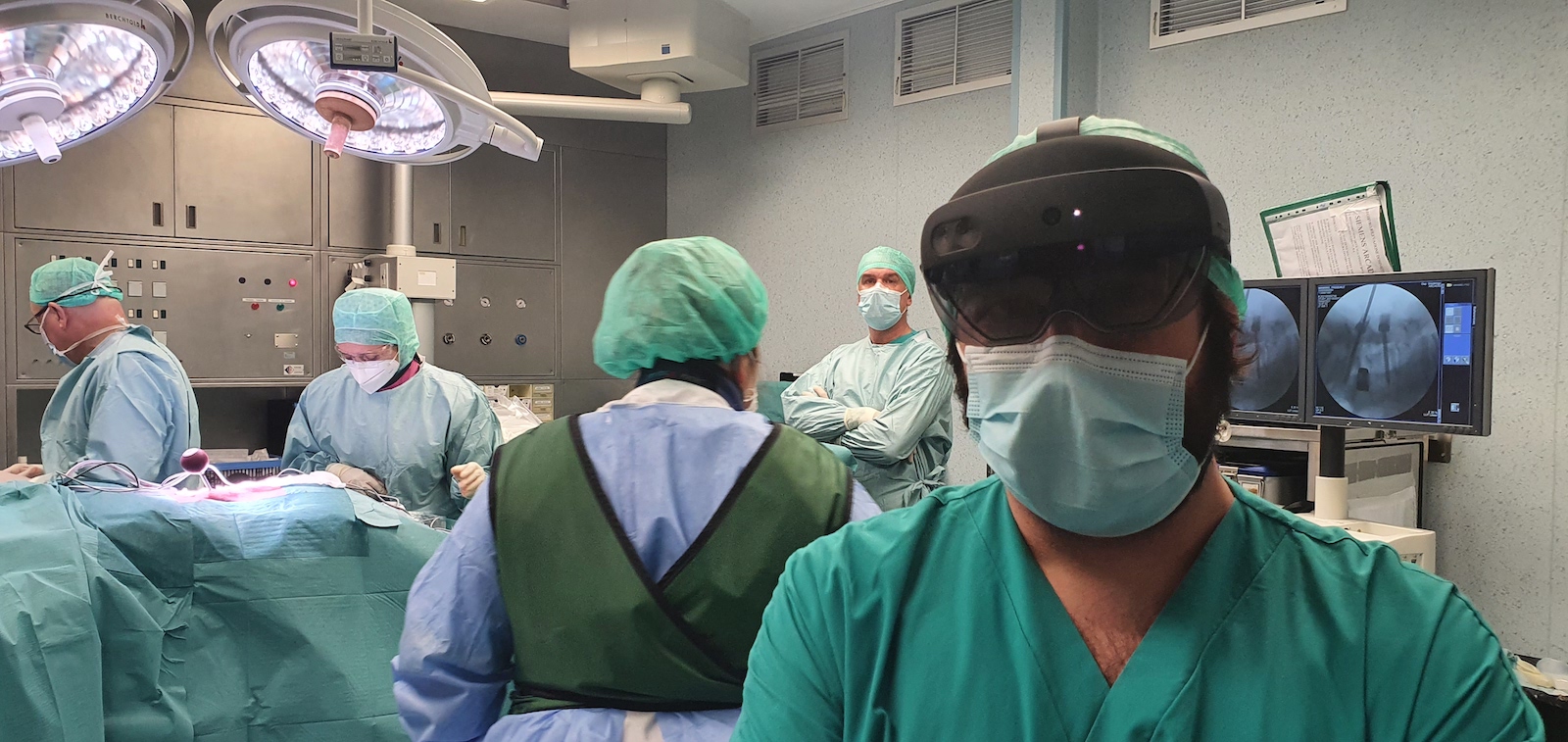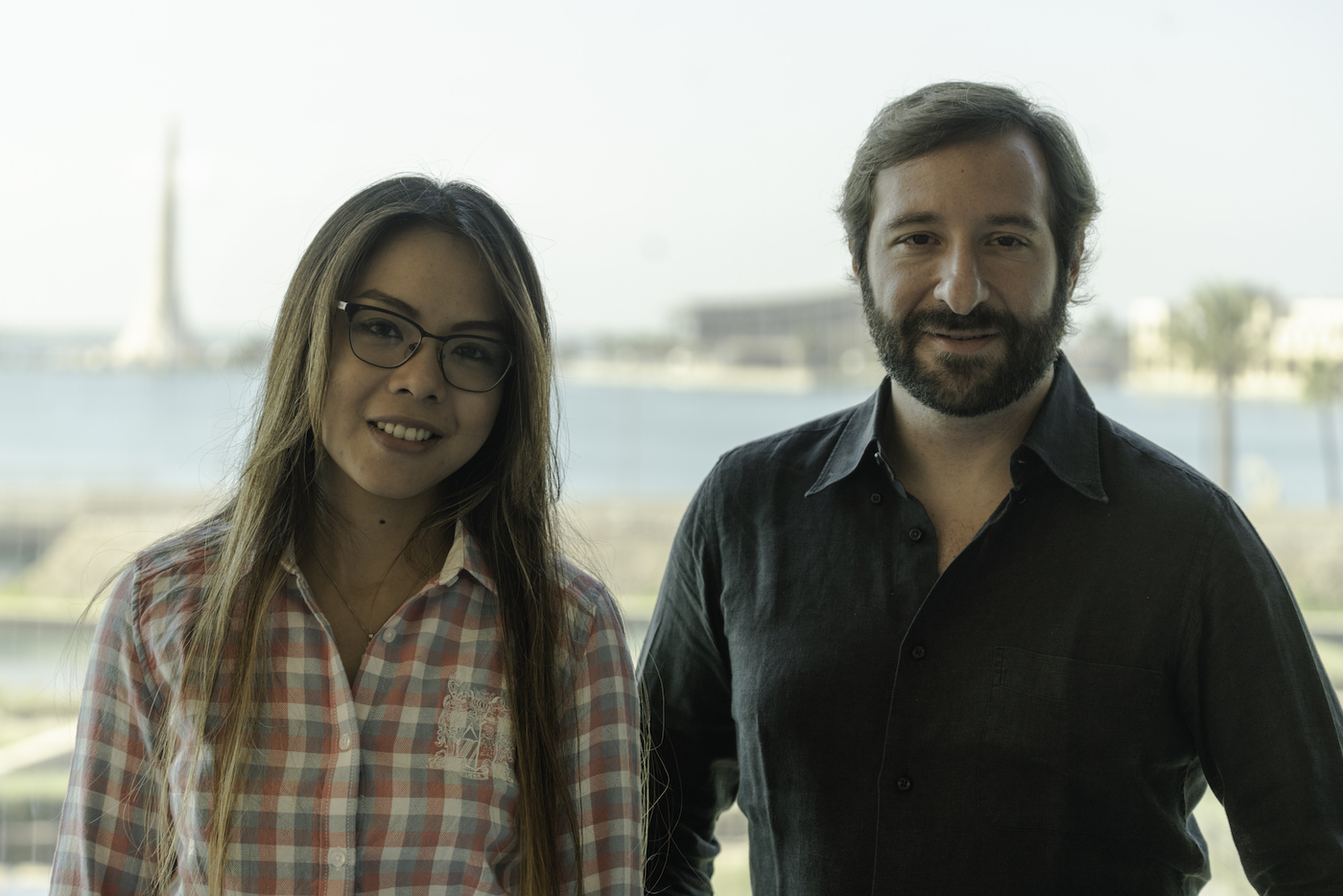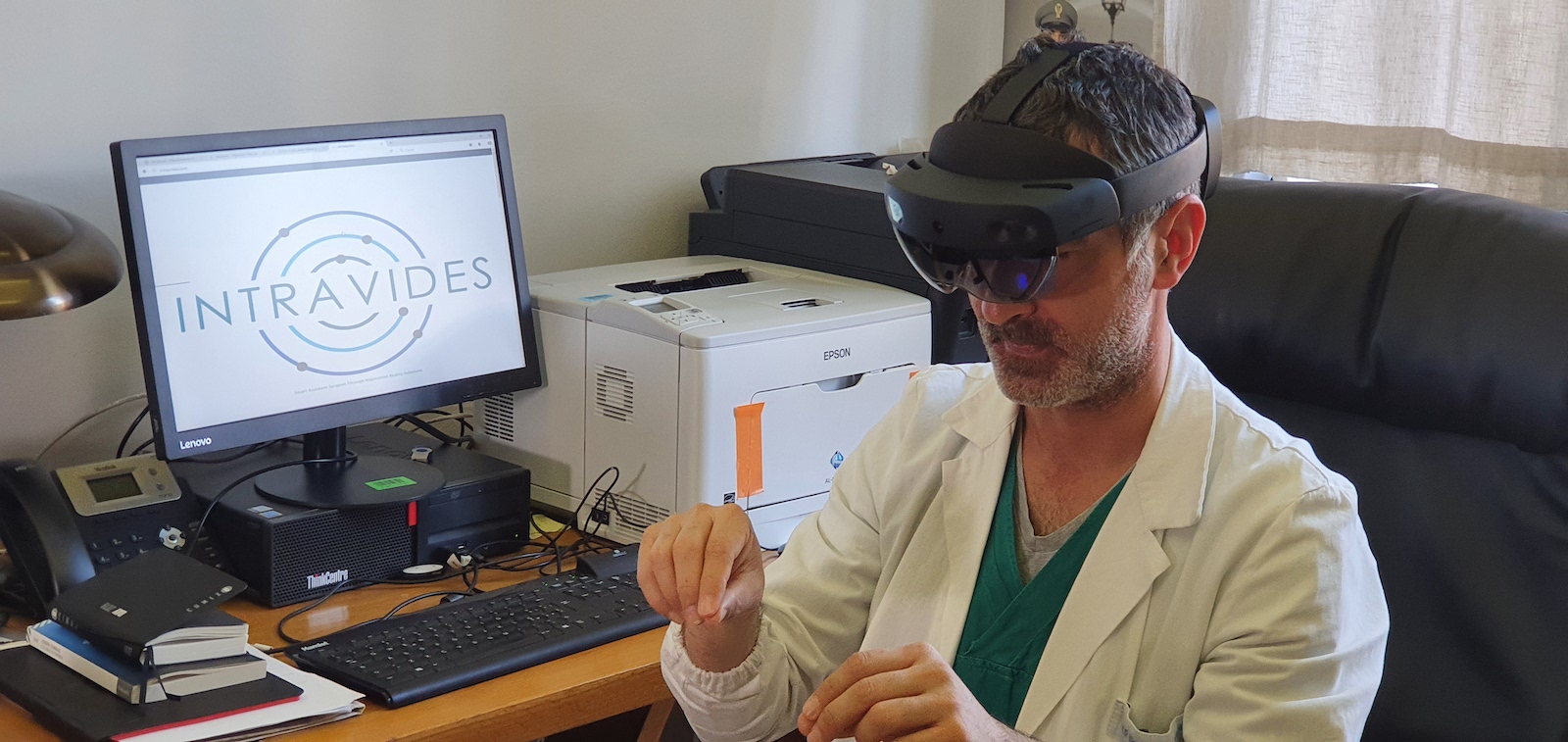KAUST students take game-changing AR tool to medical market


Dr. Calì from the University of Torino Medical School wearing Augmented Reality Headset in the operation room
"The anatomy was stunning and really accurate," says Calì, now assistant professor of human anatomy at the Neuroscience Institute Cavalieri Ottolenghi, University of Turin. "Looking at those 3D models of my own body, that's when I had the idea to use these 3D imaging skills for something medical."
Multidisciplinary team forms a startup
After the fall, Calì recovered and rejoined Magistretti's team of multidisciplinary scientists in KAUST. Still ruminating on his surgical imagery idea, Calì approached Daniya Boges, a fellow researcher in Magistretti's team, and a promising young Saudi Arabian computer scientist.
"It was sort of a natural path to collaborate on the startup idea," said Cali. "Both Daniya and I could apply what we were doing for our basic research to the startup. Daniya is a really terrific software developer, with very good skills in programming and working with three-dimensional data sets. It was a perfect complementary skillset."
Boges recalls Calì approaching her to collaborate; "He said 'How would you like to apply your software skills in a different domain? How about surgery?' and I said 'that's kind of interesting, how about we do this,'" Boges said.
KAUST as incubator
Calì and Boges were also fortunate to have Magistretti's support.
"I have always encouraged my collaborators to get involved in translational research that can lead to innovation and eventually the creation of startups," explained Magistretti. "This commitment is also a key element of the Smart Health Initiative which includes a strong component for bio-innovation."
KAUST had already invested in Augmented Reality (AR) and Virtual Reality (VR) in 2013. A VR space had been set up with some early versions of ocular devices and gear for students to try. Both Calì and Boges recall this as a crucial element to helping form their idea.
"One of the things that really pushed the boundaries of my workflow is that KAUST already had state-of-the-art visual facilities. Being engaged in that every day, submerging yourself in these tools, that really helped me," said Boges.
Crucially, they also had access to the KAUST Innovation Fund, which provides seed funding and helps with intellectual property rights, as well as the KAUST Entrepreneurship Center, which helps incubate student ideas from basic concept to thriving business.
"We approached the Innovation Fund with our initial concept in 2014, and they said 'yes you can actually have IP out of that.' Not a lot of researchers had this in mind or implemented this and that's what got us more enthusiastic about bringing it out into the real world; to make human lives a lot easier and perhaps save a lot of lives," Boges said.

KAUST former researchers and co-founders of the startup IntraVides, Daniya Boges and Dr. Corrado Calì
"Ozan Sonmez was the startup accelerator lead at the KAUST Entrepreneurship Center. Tamer Osman was the acting innovation fund head. I am grateful for those two," commented Boges.
"I didn't know that actually a researcher or scientist could become an entrepreneur," she continued. "That was not on my radar. If it wasn't for KAUST I wouldn't have believed in myself that I can take that leap of faith," Boges said.
Calì and Boges took their idea to competitions, becoming finalists in the 2014 U.C. Berkeley VentureLab, and were also selected to participate in the MENA Intel Business Competition.
Later in 2018 the KAUST Innovation Fund provided seed funding to the team.
"To be offered funding gave me huge motivation," said Boges. "It's not only the financial support, it was more than that; to be given an environment, to be told YES, this word YES, go ahead," Calì said.
IntraVides becomes a business
By 2019 the team realized they needed additional skills to fully realize the startup. That's when they were introduced to the two final co-founders, Matteo Cavalieri and Luca Damiani, who became CEO and Commercial Director of IntraVides, respectively.
"The other co-founders are mainly into the business world," said Boges. "They sort of add into the mix what Corrado and I lack. I develop the hardware and software, and Corrado is the scientist. Matteo and Luca are the business and market experts. This is a multidisciplinary collaboration and I can't think of a more contrasting mixture than what we already have."
The final concept of IntraVides was incorporated as a business in Italy in March 2021, with the four co-founders listed.
Speeding surgery, training and more
"We reconstruct the spine of the patient that needs to be operated on," explained Calì. "The surgeon uses the device to have a clear 3D picture of the patient's spine. And then with some software we show the surgeon how to place, for instance, screws that need to be implanted. All of this information is in front of the surgeon's eyes, so they can work more quickly, in a more efficient way. The patient's time under anesthesia in the operating room is lessened, which speeds up the recovery afterwards."
Additionally, IntraVides is useful as a teaching device. Calì explains; "you can have a trainee surgeon with his or her hands on the patient and the trainer surgeon giving instructions and looking exactly at what the training surgeon is doing as if it is his or her own hands - because he or she is looking from the point of view of the goggles which are placed on the eyes of the surgeons."
Finally, a key benefit that came to the fore during the pandemic is that the IntraVides device can be used to virtually connect other specialists to the OR to assist with the surgery, leading to less people in the room. "We got a prize for this during a startup competition last year," comments Cali. "During the first lockdown in Italy, we were using teleconference software on the IntraVides goggles to dial in a specialist to assist with surgical information, rather than be in the room. This has proven a great point during COVID."
Trialing AR during a pandemic
Indeed the IntraVides team were not phased by the pandemic, conducting surgical trials with the University of Turin medical school, leading to a paper being published in Frontiers in Surgery.
"In the paper we describe the trials we did with surgeons using the very first IntraVides software prototype," explains Calì. "All of the surgeries were basically spine surgeries, with the surgeons trying on the different AR devices, mainly the Microsoft HoloLens 1 and Epson BT-300 - with different software custom-made from IntraVides."
A SUS questionnaire was given to the surgeons, asking them to rank surgery with the devices compared to how it would have worked without these devices. Feedback from the surgeons was very positive. They also noted it was comfortable to wear and seamlessly added value to their process.

Professor Garbossa, neurosurgeon, full professor of neurosurgery and director of neurosurgery school at University of Torino, wears the IntraVides AR goggles
Dr. Cofano, neurosurgeon resident at the University of Torino, comments: "This technology is surprisingly easy to use and helps us to plan and perform surgery with the constant aid of a very brilliant and handy technology. Furthermore, AR could play a key role in teaching and telementoring during our activities as witnessed by our paper".
"This is the main takeaway message," says Calì. "They were enthusiastic about the portability and user friendly nature of the devices. This is really important; you want to give the specialist something you can just drop and then they switch it on and use it without going through a big training session."
The Future of IntraVides and AR in medical use
Calì is more enthusiastic than ever since the trials of the device.
"Thanks to our collaborators I am more motivated than ever, and we are receiving a lot of support from different sources as well. We are about to start a crowdfunding campaign and hope that that goes well. It will be really the pivot point that can help us to really escalate."
The next five years the co-founders have expectations to grow their market all over Europe, Saudi Arabia, and the US. "This is our expectation - to basically go global," said Calì. "I see mainly going with spinal surgery as we are skilled in that and have the connections. We would also like to spend on the training side—education is really important."
As for KAUST, the Entrepreneurship Center remains open to students to help take their ideas to market, and the Innovation Fund is delivering more seed funding than ever.
"The KAUST Innovation Fund continues to invest in and provides strategic assistance to commercially viable deep-tech startups. In 2020 alone, we closed 18 investment deals to the value of USD 11 million and were the 4th ranked active investor in MENA by Magnitt," Gary Rubin, acting head of the KAUST Innovation Fund, said.
Related
- Sensing the Future
- Red Sea Farms: Taking Aim at One of the World's Biggest Challenges
-
Wayakit Inaugurates Pilot Production Facility

